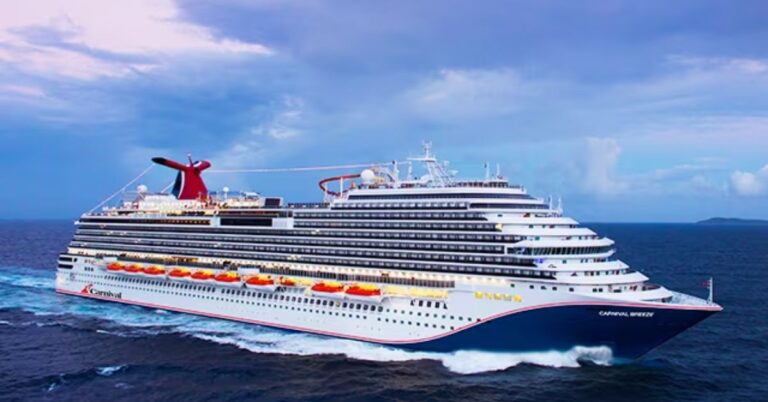Icon of the Seas Vs Titanic – A Great Comparison
In the world of maritime history, the clash between giants is not just a thing of the past. The grandeur of the Titanic once celebrated as an unrivaled marvel of its time, now faces a formidable challenger in the form of Icon of the Seas – a behemoth that would dwarf its predecessor without breaking a sweat.
As we journey back through time to explore these two colossal vessels, one cannot help but marvel at how technology and innovation have transformed our perception of size and scale over a century.
The tale of Icon of the Seas vs Titanic is more than just a comparison; it’s a testament to human ambition, ingenuity, and our unending quest to conquer the seas in style. So grab your life jacket and brace yourself for an epic showdown like no other!
Icon of the Seas Vs Titanic Size Comparison
The stark contrast in size between the Icon of the Seas and Titanic is truly staggering. With an internal volume of 240,800 GT compared to Titanic’s 46,328 GT, it is evident that the modern-day cruise ship dwarfs the iconic vessel from a bygone era. The fact that Icon of the Seas is around 35% longer than Titanic speaks volumes about how far naval engineering has progressed over the decades.

In terms of capacity alone, it’s mind-blowing to consider that Icon of the Seas can accommodate a whopping 9,950 people, including 7,600 guests and 2,350 crew members. This figure is leaps and bounds ahead of what was possible on board the Titanic with its capacity for only 2,435 guests and 892 crew members.
The sheer scale and logistical complexity of managing such a large number of passengers highlight just how advanced technology and infrastructure have become in modern maritime travel.
| Titanic | Icon of the Seas | |
| Gross Tonnage | 46,328 GT | 240,800 GT |
| Length | 882 feet | 1,198 feet |
| Width | 92.5 feet | TBC |
| Guest Decks | 9 | 18 |
| Guests | 2,435 | 7,600 |
| Crew | 892 | 2,350 |
Icon of the Seas Vs Titanic Size Comparison Speed
The similarity in cruising speeds between Titanic and the modern Icon of the Seas is a fascinating testament to naval engineering advancements over time.

Both vessels’ ability to navigate through the tumultuous seas at around 21 to 22 knots showcases the evolution of maritime technology, ensuring efficiency and safety in travel.
The capability of both ships to achieve a maximum speed close to 23 knots further underscores their prowess in conquering the waters with grace and power.
Facilities
When comparing the accommodation on Icon of the Seas to that of Titanic, it’s clear that modern cruise ships have revolutionized the concept of luxury at sea. Icon of the Seas offers spacious and beautifully designed cabins with state-of-the-art amenities, ensuring a comfortable and relaxing stay for passengers.
Titanic’s first-class accommodations may have been opulent for its time but would pale in comparison to the level of luxury found on modern-day cruise ships.
Moving on to swimming pools, Icon of the Seas boasts multiple pools with different themes and designs, catering to a variety of preferences among passengers. Titanic only had one swimming pool primarily used for exercise rather than leisure.
The evolution in cruise ship facilities highlights how contemporary vessels prioritize passenger entertainment and relaxation while also providing a high level of comfort and convenience throughout the journey.
Activities
On board the Icon of the Seas, guests are treated to a thrilling array of activities that redefine the notion of shipboard entertainment. The over-the-edge ropes course and indoor AquaTheater offer unique experiences that blend excitement with luxury.
While Titanic boasted elegant deck games like quoits and shuffleboard, Icon of the Seas takes classic pastimes to new heights with its larger-than-life chess set.

The comparison between the activities on the Icon of the Seas and those found on Titanic underscores the evolution of onboard entertainment throughout history. From rock climbing to laser tag, modern cruise ships like Icon of the Seas cater to adventurous spirits seeking immersive experiences at sea.
While Titanic may have had its own charm with squash courts and traditional games, today’s travelers can relish in a fusion of innovation and tradition on vessels like Icon of the Seas.
Swimming Pools
The contrasting approach to swimming pools aboard the Icon of the Seas and the Titanic symbolizes a shift in luxury travel standards.
While the Titanic restricted access to its pool, creating a sense of exclusivity tied to social class, Icon of the Seas offers a more inclusive and contemporary experience with multiple pools accessible to all guests. The swim-up bar on board represents a fusion of leisure and socializing, redefining the traditional concept of poolside relaxation.
Dining
Icon of the Seas sets a new standard in the realm of dining experiences, boasting a staggering 15 restaurants within the Royal Promenade area alone.

This unparalleled variety ensures that guests can indulge in diverse culinary delights without ever having to leave the ship’s bustling hub. Titanic’s four restaurants, while luxurious for its time, pale in comparison to the abundance offered on Icon of the Seas.
Accommodation
As we compare the accommodations on the Icon of the Seas with those on Titanic, it’s evident that both offer luxurious options, albeit in different ways. The Ultimate Family Townhouse on the Icon of the Seas caters to modern sensibilities with its unique features like slide connecting rooms and charming exterior elements.
The Deluxe Parlour Suites on Titanic exude grandeur with their spacious layout and elegant furnishings, reminiscent of a bygone era.
Icon of the Seas vs Titanic – Safety
The comparison between the Titanic and modern cruise ships like Icon of the Seas reveals significant advancements in safety measures and technology.

While the Titanic had 20 lifeboats for its 2,240 passengers and crew, modern ships like Icon of the Seas have enough lifeboats to accommodate all passengers, ensuring a higher chance of survival in case of an emergency.
Improved navigation systems, advanced engineering techniques, and stringent safety protocols make it highly unlikely for a modern cruise ship to suffer the same fate as the Titanic.
Cost to Build
While early estimates pegged Icon of the Seas’ construction at $2 billion, recent insights suggest it could land closer to $1.3 billion, showcasing remarkable efficiency gains over time.
The Titanic’s build cost was a mere $7.5 million during its era, underlining not only inflationary pressures but also the substantial leap in complexity and luxury standards demanded by modern cruise ships.
Conclusion
Icon of the Seas Vs Titanic reveals the advancements in maritime technology and safety measures over the years. While Titanic was a marvel of its time, Icon of the Seas represents the pinnacle of modern ship design and engineering. The tragic fate of Titanic serves as a reminder of the importance of prioritizing safety in all aspects of shipbuilding.
As we continue to innovate and improve upon past mistakes, let us honor the legacy of those lost on Titanic by ensuring that ships like Icon of the Seas set a new standard for safety at sea. Join us in advocating for continued advancements in maritime safety to prevent history from repeating itself.
FAQ’s
Is the Icon of the Seas Bigger Than the Titanic?
At 1198 feet long and boasting a gross tonnage of 240,800 GT, the Icon represents modern innovation at its finest. In comparison, the Titanic’s modest dimensions of 882 feet in length and 46,328 GT pale in comparison to this maritime marvel.
How Many Passengers Are on the Icon of Seas?
With a capacity of 7600 passengers, the Icon of the Seas provides ample space for a vast number of people to experience luxurious cruising on a grand scale. Titanic was designed to carry only 2435 passengers, highlighting how cruise ships have evolved to cater to larger crowds.






